This year, one of our biggest priorities has been to run various experiments on different sections of our products. Whether it be small scale changes like adding an "Get App" button to our site, or bigger ones like redesigning our whole website, we have been investing a lot of our time in tinkering with our products.
By running these experiments from time to time, we aim to test our new theories and ideas in order to produce better versions of our products — consequently giving our users the best product possible.
In this spirit, we recently squared off three proven psychological theories in marketing our app to see which theory would bring us the best results. Today, we'd like to share these with you. We don't share these results to push it as a best practice for marketing your products. Rather, we do so to give you a small glimpse of how we work at Programiz, and to possibly inspire you to try these experiments in your own projects.
Without any further adieu, let's get started with the story.
Our First Step: Marketing our Python App
Last year, we launched our app - Learn Python: Programiz - in the month of April 2019. Within the first year of the launch, the app had been downloaded over 130k times ?. Besides a "Get App" link on our website and a short-lived product launch on ProductHunt, it's fair to say we have not marketed our app as much as we would have liked.
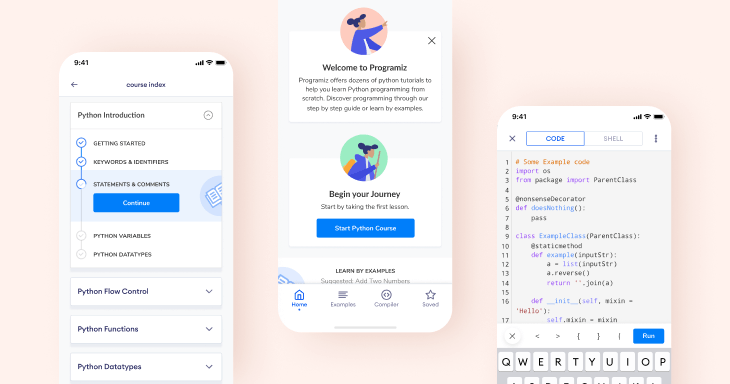
However, after we released the Learn Python: Programiz 2.0 app along with an in-built compiler and quizzes, we finally decided to invest more time and budget into marketing our app. That's what we did last month, but we did one thing differently.
Instead of pushing out random marketing messages, we tried harnessing the power of psychology to get our message across. We took this particular route because as marketers, we always want to know how our customers behave and potentially tap these behavioral traits to our advantage. And, that's what Psychology is all about.
Our Work Process
We wanted to have a clear direction on how we wanted to run our marketing campaigns. We were clear on one thing though: we wanted to create positive engagement with our viewers. So we started working on a solid workflow that would provide us with the flexibility to experiment.
Finally, we settled on a four-step process:
- brainstorming,
- designing,
- voting,
- and finally, publishing.
Step 1: Brainstorming
We were clear that we wanted to test psychological theories for our marketing campaign. However, it is not as easy as it sounds. There is no one-size-fits-all principle that could exponentially increase our downloads overnight and adhere to our values at Programiz.
Naturally, we had to select a few (among dozens of theories) and test them. So, we selected three powerful psychological theories and ran three different campaigns to see which amongst the three fit best to our values and goals. They are:
- Framing Effect
- Conformity and Social Influence
- Cognitive Dissonance
After we decided on what theories we wanted to test, we start writing down marketing copies for each category. We aren't very picky at this stage. We brainstorm a lot of copies and just list them out. The goal at this stage is to come up with as many ideas as possible.
Step 2: Prototyping
Our next step was to create a design prototype for the copies we just listed out. We started out by creating multiple artworks based on the copy so that we could reuse them fittingly. This ensured that we didn't have to create artworks for each and every copy, which gave us ample time to maintain the quality of our works.
Step 3: Voting
Once the designs were ready, we voted on the designs. Only the best of the bunch were selected for A/B testing.
Step 4: Publishing
For publishing, we chose Facebook and Instagram as our go-to marketing platforms, due to both our considerable experience with these platforms and also because we already had Facebook Pixel installed on our website.
We then started an FB and Insta ad campaign with various A/B test samples. The results from the A/B test provided us with the most effective sample. For the next iteration, we selected the winner as the sample for another round of testing.
As for the duration of the experiment, we decided that we would run our ad campaign for 1 week and then analyze the results.
Before We Move Further
To test the effectiveness of our campaigns, we primarily looked at two things: Click-through Rate (CTR) and Cost Per Link Click (CPC).
These were important to us because CTR told us how often people stopped scrolling to click the link on our ads, while CPC told us whether the click was worth our money or not.
If you want to know more about these metrics and other marketing terminologies mentioned in the article, we recommend you to refer to falcon.io’s blog.
Now that these are out of the way, let's move on with the individual campaigns and their outcomes.
Test 1: The Framing Effect
People make decisions based on whether a situation is a gain or a loss scenario for them.
Marketers use this human behavior to their advantage to convince people in decision making. The marketing could emphasize benefits that the users might gain from our products, or they could emphasize the potential loss of opportunities if our products are not used. This difference in emphasis led to us classifying this psychological effect into 3 categories:
- Positive Framing
- Negative Framing
- Statistical Framing
For this test, we will be choosing one or more copies from each of the 3 categories we stated above and running a A/B test to determine the winner.
Now let us look at each of these categories in greater detail.
Positive Framing
In positive framing, we set a scenario where the recipient can potentially gain from the situation.
Let’s see what copies we came up with for a gain scenario:
Copy 1: Be a python guru with Programiz.
Copy 2: Start a brilliant python career.
Copy 3: Starting out coding? Programiz makes every concept easier to understand.
Here our goal is to show what the users will benefit by using our app. We wanted to primarily target students, so we chose a gain scenario of a positive career outcome.
Our goal was to target beginners and increase conversion. For this, we provided a solution that negates the chances of beginners getting overwhelmed by what they perceive to be the difficulties of learning programming.
For positive framing, we selected Copy 1 for the A/B test. Our final ad design looks like this:
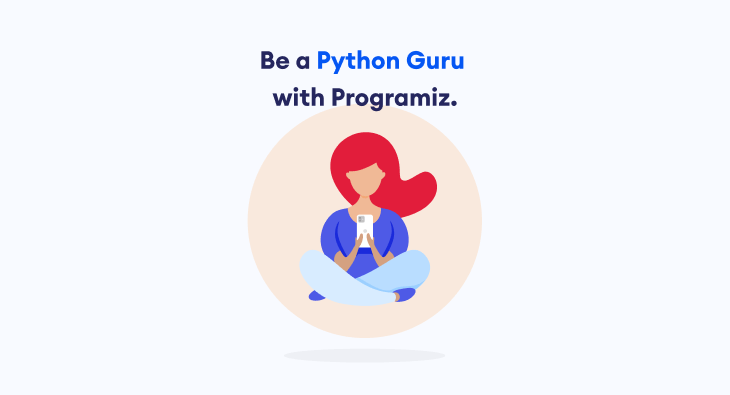
Negative framing
In negative framing, we set a scenario to be a loss situation for the recipient if they fail to comply with the message.
Negative framing is most commonly used in political marketing. For example: “Candidate A has X shortcomings to the preferred candidate B”.
Since this does not align with Programiz’s marketing practices, we limited this to two copies:
Copy 1: Tired of boring coding lessons? Learn Python: Programiz makes learning fun.
Copy 2: Tired of trying out different Python apps? The definitive Python app is here.
Our copies were very subtle in the negative scenario aspect. Here we were just making a subtle statement that coding lessons from other sources are boring and our app makes learning fun.
However, since negative framing doesn't fit into our company values, we decided to only create designs for the first copy. This was a carousel type ad where users see the first image and then swipe to the next one.
This ad is not purely negative framed, as it has a bit of a dissonance effect added to it.
[More on dissonance later in this article]
Here is the final design for the carousel ad:
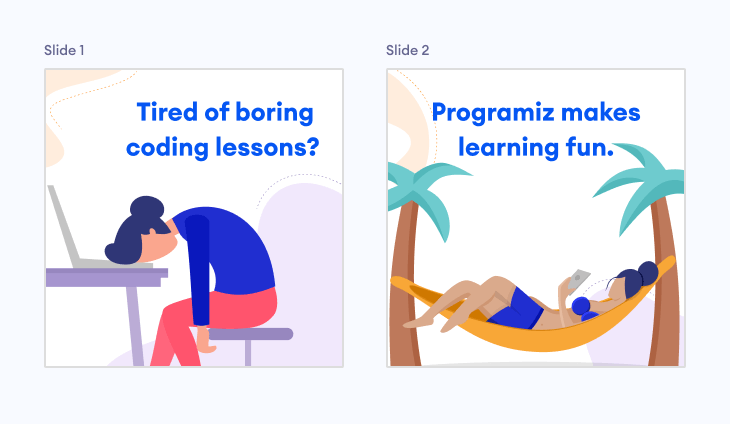
Statistical framing
In statistical framing, we use statistics to set a scenario to be a gain situation. Simply put, we use statistics on top of positive framing.
Let’s dive straight into our copies for statistical framing:
Copy 1: Over 2 million students rely on Programiz to start their careers.
Copy 2: Carousel Ad Copy for Statistical framing (Tell a story in 5 images):
- Image 1: Facebook Python Developer earns $190,000.
- Image 2: Google Python Developer earns $150,000.
- Image 3: An average Python Developer earns $110,000.
- Image 4: Programiz simplifies Python into bite-sized lessons.
- Image 5: Start programming today. Install Now.
We wanted to show a positive scenario for our target demographic, which is mostly comprised of students. The most widely asked question by students are - "Which language is better for their career?".
So we structured our copies in such a way that this particular query is answered (our answer being Python, of course).
We even went one step further with our carousel ad by detailing the average salaries of Python developers. This serves to create interest and would motivate the user to swipe to the next slide in the carousel.
We selected the carousel ad (Copy 2) for our testing. However, we also made a short video ad with the same 5 images used in the carousel ad. Both of these ad samples were used in our A/B testing.
Below are the variations we created for statistical framing:
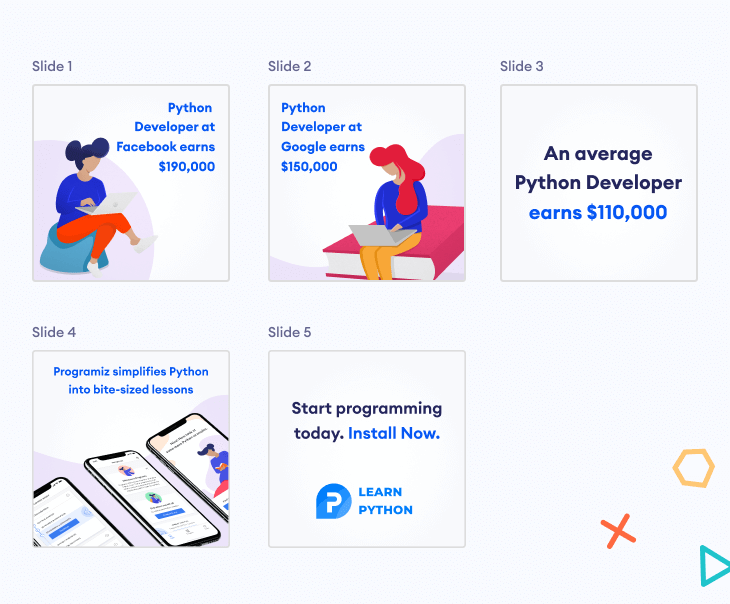
Results for Framing Ad Campaign
Again stressing on the point that we will be looking at all campaign results using only two metrics: CTR(Link Click-through Rate) & CPC(Cost Per link Clicks).
Let’s begin by examining the CTR graph below:
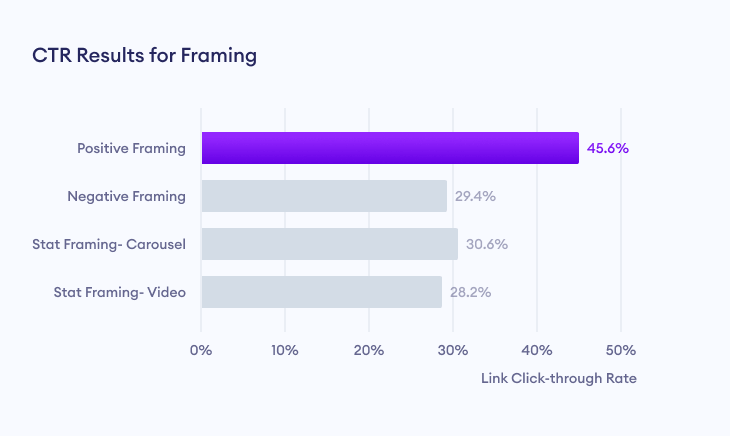
Positive framing had the highest link click-through rate with 45.6%. This makes positive framing the clear winner with a 15% lead over the runner up.
Now moving on to the CPC graph:

Positive framing also had the lowest cost per link click with $0.16. Again, compared to the runner-up we are saving 33% per link click costs. We can conclude that a gain-scenario marketing technique works best for our app category.
If you want to learn more about using framing in marketing, I suggest you read my article on the Framing Effect.
Test 2: Conformity and Social Influence
We change our behavior to be more like others.
People conform because it makes decision making easier during unsure situations. Some conform so that they can be associated with a certain group of people. And some conform because they don’t want to be judged by people as being too different.
A basic example would be companies using Hollywood stars as their brand ambassadors. People look up to celebrities and admire them. So when they endorse a product, consumers are more likely to buy them because, consciously or unconsciously, they wish to associate themselves with their favorite celebrities. This is social conformity in action.
But celebrities aren't the only people who have the power to influence consumers: our own families and friends and communities (and society at large) are the most potent forces behind our urge to conform. Most of us tailor our thoughts, attitudes and life choices based on the attitudes of our family and the broader society.
So we decided to harness the power of social solidarity instead of turning to celebrities (and also because we don't have the cash required to pocket a celebrity?). Below are the copies that we came up with:
Copy 1: The new Python app everyone is talking about.
Copy 2: Thousands have jumped started their Python career with Programiz.
Copy 3: Programiz is the go to app for new programmers.
Copy 4: Over 2 million students rely on Programiz to start their careers.
Notice how the emphasis of these ads is on how other people are using our app with fantastic results.
This instantly kicks our primal instinct to conform to the choices of these "other people" who are having such an amazing time with our app. "If all these other people have benefited so much from this app, perhaps I will too.", thinks the prospective customer.
We then selected only two of the designs from the variations for A/B testing.
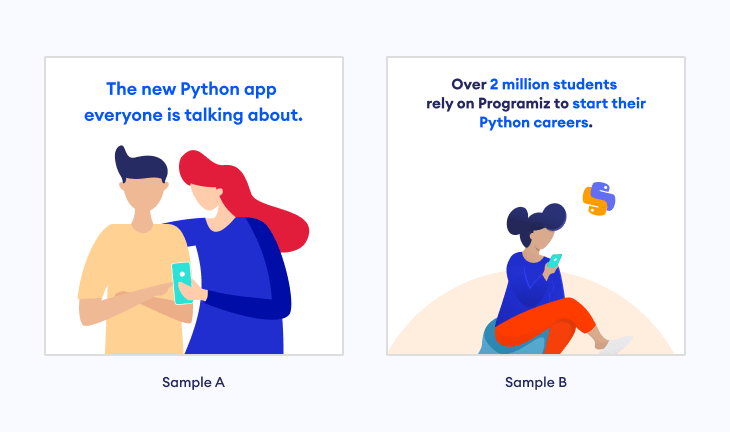
Then we turned these designs into animated videos. From our Framing tests, we noticed that people are investing more on video ads. However, we also noticed that longer videos tend to perform lower than short looped videos. So to test this again, we created the first design into a looped animation. The second design was a longer storyboarded animation.
Results for Conformity Ad Campaign
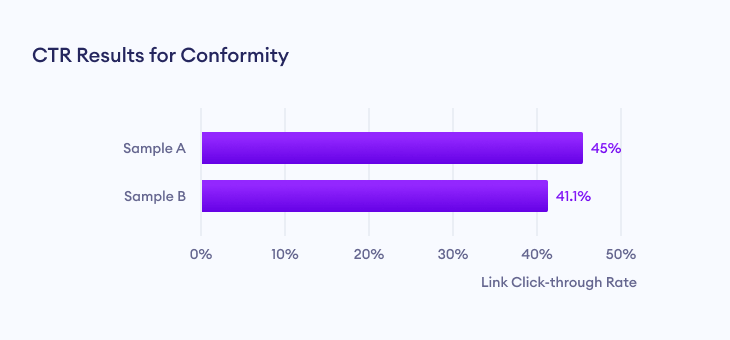
Sample A has a CTR of 45% while Sample B has a CTR of 41.1%. The CTR difference between the two samples is very narrow. A 4% difference is not very conclusive for us to select a winner.
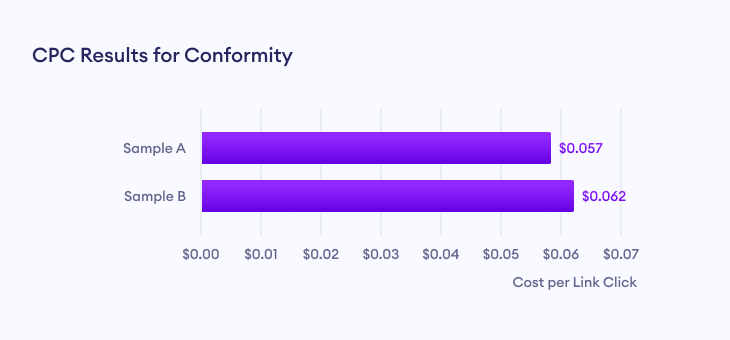
Let's look at the CPC chart to determine a winner. Here Sample A has the lowest CPC of $0.057 which is a saving of 8%. So, we can award Sample A with a narrow victory over Sample B. Notice that both samples are animated but Sample B is longer in playback length.
Even though we have a winner for our test, we can't conclusively say that one performed better than the other. We may have to get back to this test with more samples over a longer period.
[Update : May 2020]
Since the first experiment was inconclusive, we reconducted the conformity experiment for the month of May. This time we increased the audience sample as well as the campaign duration to a month. Increasing the sample size will help us get more conclusive results.
Let’s look at the new CTR and CPC results now.
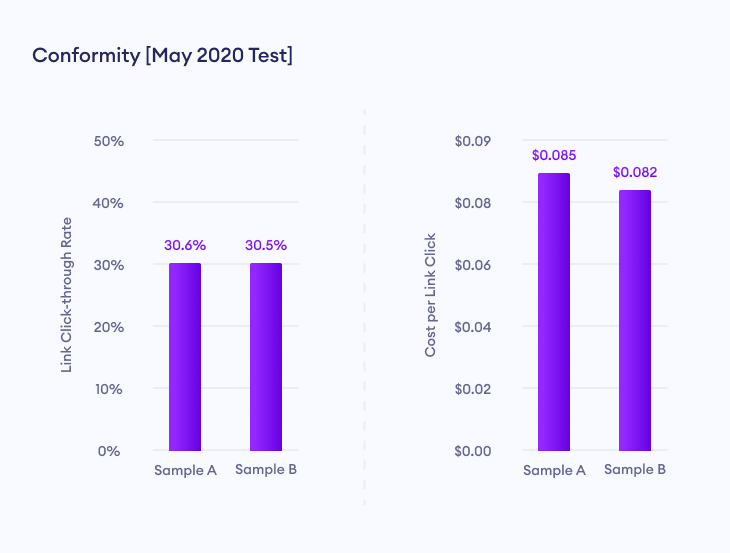
Both the ads performed too similarly even with larger sample sizes and budget. Both CTR and CPC results are so close that any differences are negligible. So, we concluded that all our ads for conformity are winners.
A thing to note is that the CTR results are a bit low at 30% which is not favorable compared to the other tests. Hence, we have added new tests comparing "framing vs dissonance" to find out the final winner.
If you want to learn more about using conformity in marketing, I suggest you read my article on the Conformity Bias.
Test 3: Cognitive Dissonance
We try to reach a state of consonance(mental comfort) when we face a situation of discomfort.
The most common marketing example of this phenomenon would be when we see marketing titles such as “7 financial mistakes you make”. We are now in a state of mental discomfort: on one hand, we don’t want to make financial mistakes, but on the other hand, we know we can make financial mistakes very easily. So we click on this marketing link so that we can find the solution to resolve this problem.
Let’s take a look at our copies for this campaign:
Copy 1: Learning to code takes time. Learn Python: Programiz makes learning Python easy.
Copy 2: Tired of boring coding lessons. Learn Python: Programiz makes learning fun.
Copy 3: Tired of installing Python on your computer? With Learn Python: Programiz you can run python code directly from your phone.
Copy 4: Skip bulky books. Enjoy bite-sized Python lessons in an app.
Copy 5: Learning to code takes time. Learn python hands-on with Programiz app.
Remember how we avoid portraying programming and coding as a difficult learning process in positive framing? Now we are going to do the exact opposite. Now we are going to put out a real problem and then give a valid solution. Hence, we state that programming is a difficult skill to acquire, but the solution is to learn python from our app since it makes learning easier.
For our A/B testing, we have three samples: Sample A and Sample B using Copy 1 where Sample A is a carousel ad and Sample B is a video ad. Finally, we chose Copy 5 for Sample C.
Since dissonance can be a bit tricky, we went with a tame marketing practice for this. Going overly aggressive like “You are coding Python wrong” or something similar doesn’t really work well with our ethical practices. Here are the designs for Sample A and C:
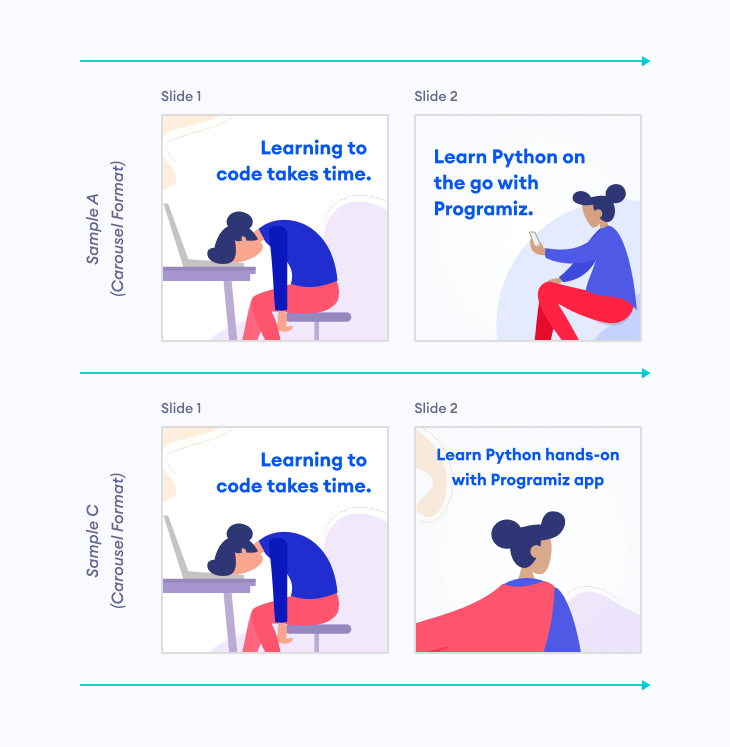
Results for Cognitive Dissonance Ad Campaign
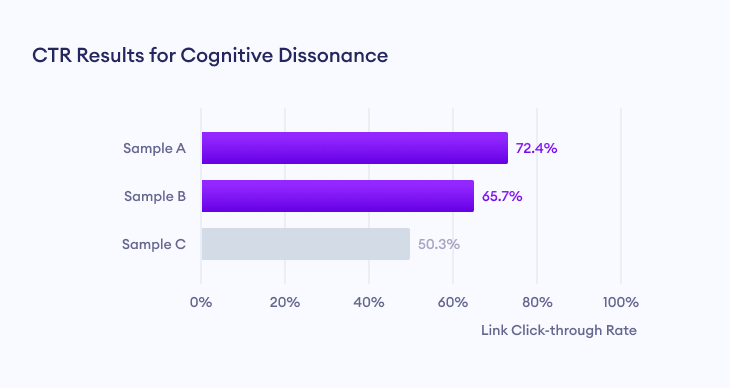
Looking at the CTR results, we can see that Sample A and B have some impressive numbers with 72.4% and 65.7% respectively. These are very close performance numbers, relatively speaking. This might be because both these samples are the same copy, but the former is a carousel ad and the latter is a video ad. Sample C is way behind with a CTR of 50.3%.
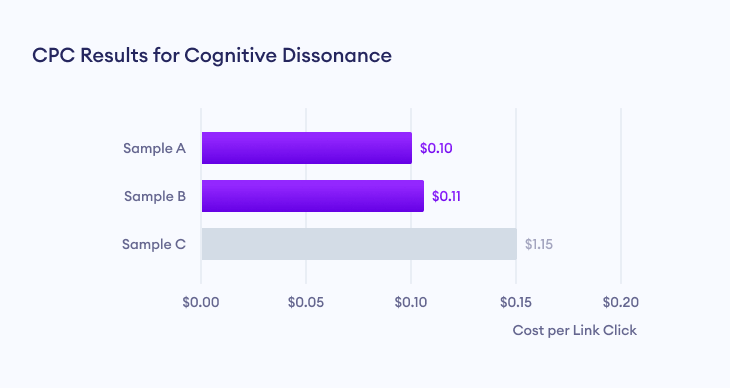
We can notice the same trend with the CPC results. Sample A and B have basically the same results with CPC values of $0.10 and $0.11 respectively. Sample C is a tad bit expensive with per link click costing us 26% more than other samples.
For this test, we concluded that Sample A carousel ad is the winner.
If you want to learn more about cognitive dissonance, I suggest you read my article on Cognitive Dissonance.
Making sense of the numbers
The results of the conformity campaign show that the performance of the two copies are very very close. We think that we didn't have enough time to test.
So, we can narrow down our comparison to Framing vs Dissonance.
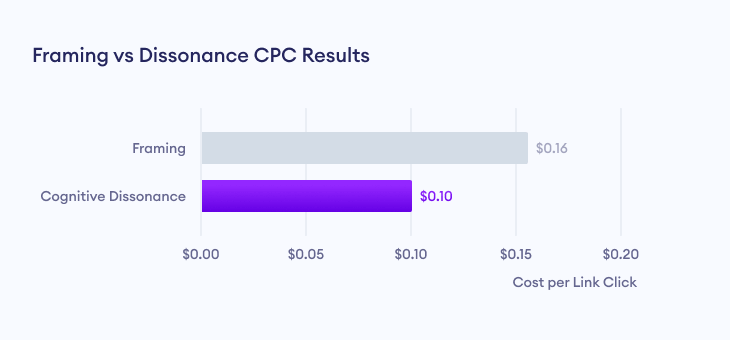
Our winner from the Framing campaign has a CTR of 45% and CPC of $0.16. Looking at the same metrics over at the Dissonance campaign, we have a best CTR rate of 72.4% and a CPC rate of $0.10. This is an interesting outcome with dissonance having a higher CTR lead of 27.4% and a per link-click cost savings of 37.5%.
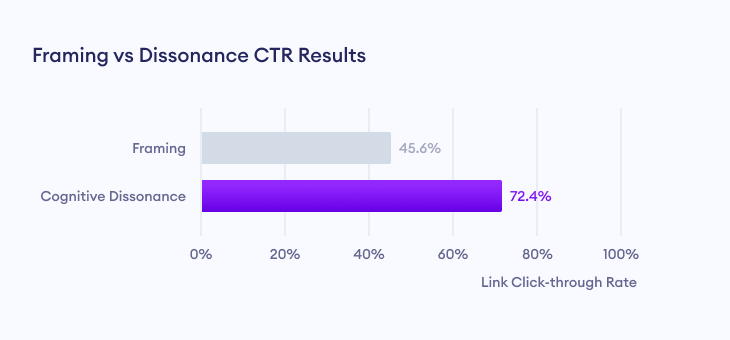
From this test, it seems that cognitive dissonance is more effective than positive framing for marketing. But it should be remembered that this outcome was achieved from a week of running ad campaigns. We will also be performing an ad campaign with these two psychologies as A/B samples. This is because we want to see if the same outcomes are observed with a larger audience sample and a campaign runtime of months instead of weeks.
[Update : May 2020]
For the month of May, we ran another campaign where the A/B samples were the winning ads from framing(positive framing) and dissonance. We increased the audience sample and ran the campaign for a month. Take a look at the results below.
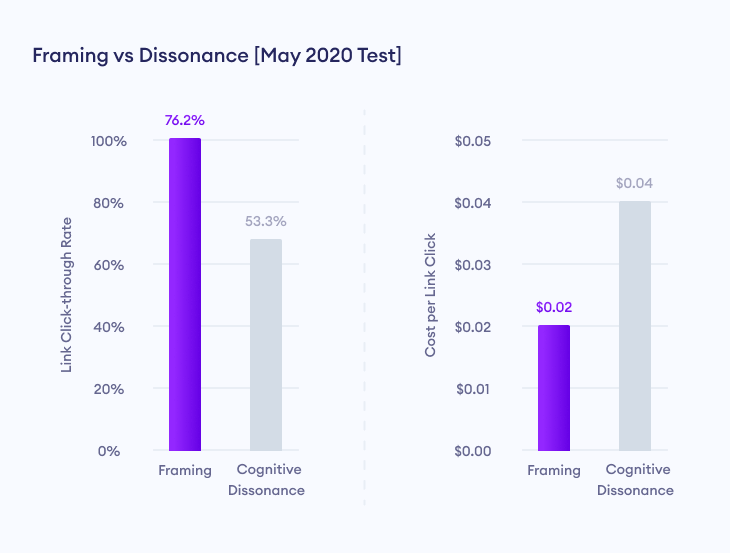
Here, positive framing leads with 23% on CTR results and costs 50% less than the dissonance campaign. So, with this new data, we can conclude that Framing is the clear winner of the A/B test, and the overall winner for the whole showdown.
Takeaways
The results are quite interesting and not what our team initially expected. We had high hopes for positive framing because it was very straightforward and many marketing campaigns used this technique. We were surprised when the dissonance campaign outperformed the positive framing campaign. This gave us a different insight into how users think and act.
Our mindset has changed after performing these experiments. We were pretty timid when it came to marketing but now we are itching to run more tests. For us, this means relying less on intuition and more on data. This has opened up an avenue for more campaign testing on cognitive dissonance (with a bit more aggressive tone).
Our experimentation on using marketing psychology proved to be a success. Our success metric not only depends on app downloads but also on what we learned from the experience. It showed that we are on the right track. For us to perform these experiments and share with all of you has been a wonderful experience and we aim to share more of our stories and experiments with you in the days to come. So stay tuned.
Subscribe to Programiz Blog!
Be the first to receive the latest tutorial from Programiz by signing up to our email subscription. Also more bonus like inside looks on the latest feature and many more.




